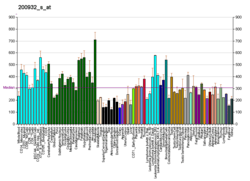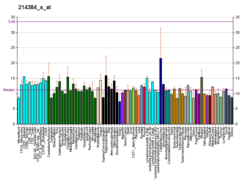DCTN2
Dynactin subunit 2 is a protein that in humans is encoded by the DCTN2 gene.[3][4]
Function
This gene encodes a 50-kD subunit of dynactin, a macromolecular complex consisting of 10-11 subunits ranging in size from 22 to 150 kD. Dynactin binds to both microtubules and cytoplasmic dynein. It is involved in a diverse array of cellular functions, including ER-to-Golgi transport, the centripetal movement of lysosomes and endosomes, spindle formation, chromosome movement, nuclear positioning, and axonogenesis. This subunit is present in 4-5 copies per dynactin molecule. It contains three short alpha-helical coiled-coil domains that may mediate association with self or other dynactin subunits. It may interact directly with the largest subunit (p150) of dynactin and may affix p150 in place.[4]
Interactions
DCTN2 has been shown to interact with MARCKSL1.[5]
References
- ↑ "Human PubMed Reference:".
- ↑ "Mouse PubMed Reference:".
- ↑ Echeverri CJ, Paschal BM, Vaughan KT, Vallee RB (July 1996). "Molecular characterization of the 50-kD subunit of dynactin reveals function for the complex in chromosome alignment and spindle organization during mitosis". J. Cell Biol. 132 (4): 617–33. PMC 2199864
 . PMID 8647893. doi:10.1083/jcb.132.4.617.
. PMID 8647893. doi:10.1083/jcb.132.4.617. - 1 2 "Entrez Gene: DCTN2 dynactin 2 (p50)".
- ↑ Yue L, Lu S, Garces J, Jin T, Li J (August 2000). "Protein kinase C-regulated dynamitin-macrophage-enriched myristoylated alanine-rice C kinase substrate interaction is involved in macrophage cell spreading". J. Biol. Chem. 275 (31): 23948–56. PMID 10827182. doi:10.1074/jbc.M001845200.
Further reading
- Maruyama K, Sugano S (1994). "Oligo-capping: a simple method to replace the cap structure of eukaryotic mRNAs with oligoribonucleotides". Gene. 138 (1-2): 171–4. PMID 8125298. doi:10.1016/0378-1119(94)90802-8.
- Suzuki Y, Yoshitomo-Nakagawa K, Maruyama K, Suyama A, Sugano S (1997). "Construction and characterization of a full length-enriched and a 5'-end-enriched cDNA library". Gene. 200 (1-2): 149–56. PMID 9373149. doi:10.1016/S0378-1119(97)00411-3.
- Starr DA, Williams BC, Hays TS, Goldberg ML (1998). "ZW10 helps recruit dynactin and dynein to the kinetochore". J. Cell Biol. 142 (3): 763–74. PMC 2148168
 . PMID 9700164. doi:10.1083/jcb.142.3.763.
. PMID 9700164. doi:10.1083/jcb.142.3.763. - Berrueta L, Tirnauer JS, Schuyler SC, Pellman D, Bierer BE (1999). "The APC-associated protein EB1 associates with components of the dynactin complex and cytoplasmic dynein intermediate chain". Curr. Biol. 9 (8): 425–8. PMID 10226031. doi:10.1016/S0960-9822(99)80190-0.
- Eckley DM, Gill SR, Melkonian KA, Bingham JB, Goodson HV, Heuser JE, Schroer TA (1999). "Analysis of dynactin subcomplexes reveals a novel actin-related protein associated with the arp1 minifilament pointed end". J. Cell Biol. 147 (2): 307–20. PMC 2174220
 . PMID 10525537. doi:10.1083/jcb.147.2.307.
. PMID 10525537. doi:10.1083/jcb.147.2.307. - Karki S, Tokito MK, Holzbaur EL (2000). "A dynactin subunit with a highly conserved cysteine-rich motif interacts directly with Arp1". J. Biol. Chem. 275 (7): 4834–9. PMID 10671518. doi:10.1074/jbc.275.7.4834.
- Merdes A, Heald R, Samejima K, Earnshaw WC, Cleveland DW (2000). "Formation of spindle poles by dynein/dynactin-dependent transport of NuMA". J. Cell Biol. 149 (4): 851–62. PMC 2174573
 . PMID 10811826. doi:10.1083/jcb.149.4.851.
. PMID 10811826. doi:10.1083/jcb.149.4.851. - Yue L, Lu S, Garces J, Jin T, Li J (2000). "Protein kinase C-regulated dynamitin-macrophage-enriched myristoylated alanine-rice C kinase substrate interaction is involved in macrophage cell spreading". J. Biol. Chem. 275 (31): 23948–56. PMID 10827182. doi:10.1074/jbc.M001845200.
- Vancoillie G, Lambert J, Haeghen YV, Westbroek W, Mulder A, Koerten HK, Mommaas AM, Van Oostveldt P, Naeyaert JM (2000). "Colocalization of dynactin subunits P150Glued and P50 with melanosomes in normal human melanocytes". Pigment Cell Res. 13 (6): 449–57. PMID 11153697. doi:10.1034/j.1600-0749.2000.130607.x.
- Hoogenraad CC, Akhmanova A, Howell SA, Dortland BR, De Zeeuw CI, Willemsen R, Visser P, Grosveld F, Galjart N (2001). "Mammalian Golgi-associated Bicaudal-D2 functions in the dynein-dynactin pathway by interacting with these complexes". EMBO J. 20 (15): 4041–54. PMC 149157
 . PMID 11483508. doi:10.1093/emboj/20.15.4041.
. PMID 11483508. doi:10.1093/emboj/20.15.4041. - Short B, Preisinger C, Schaletzky J, Kopajtich R, Barr FA (2002). "The Rab6 GTPase regulates recruitment of the dynactin complex to Golgi membranes". Curr. Biol. 12 (20): 1792–5. PMID 12401177. doi:10.1016/S0960-9822(02)01221-6.
- Gevaert K, Goethals M, Martens L, Van Damme J, Staes A, Thomas GR, Vandekerckhove J (2003). "Exploring proteomes and analyzing protein processing by mass spectrometric identification of sorted N-terminal peptides". Nat. Biotechnol. 21 (5): 566–9. PMID 12665801. doi:10.1038/nbt810.
- Uetake Y, Terada Y, Matuliene J, Kuriyama R (2004). "Interaction of Cep135 with a p50 dynactin subunit in mammalian centrosomes". Cell Motil. Cytoskeleton. 58 (1): 53–66. PMID 14983524. doi:10.1002/cm.10175.
- Brill LM, Salomon AR, Ficarro SB, Mukherji M, Stettler-Gill M, Peters EC (2004). "Robust phosphoproteomic profiling of tyrosine phosphorylation sites from human T cells using immobilized metal affinity chromatography and tandem mass spectrometry". Anal. Chem. 76 (10): 2763–72. PMID 15144186. doi:10.1021/ac035352d.
- Ballif BA, Villén J, Beausoleil SA, Schwartz D, Gygi SP (2004). "Phosphoproteomic analysis of the developing mouse brain". Mol. Cell Proteomics. 3 (11): 1093–101. PMID 15345747. doi:10.1074/mcp.M400085-MCP200.
- Ficarro SB, Salomon AR, Brill LM, Mason DE, Stettler-Gill M, Brock A, Peters EC (2005). "Automated immobilized metal affinity chromatography/nano-liquid chromatography/electrospray ionization mass spectrometry platform for profiling protein phosphorylation sites". Rapid Commun. Mass Spectrom. 19 (1): 57–71. PMID 15570572. doi:10.1002/rcm.1746.

